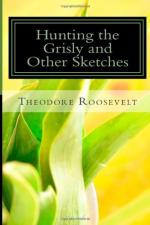Hitherto, however, the mountain hunters—as distinguished from the trappers—who have followed the grisly have relied almost solely on their rifles. In my own case about half the bears I have killed I stumbled across almost by accident; and probably this proportion holds good generally. The hunter may be after bear at the time, or he may be after blacktail deer or elk, the common game in most of the haunts of the grisly; or he may merely be travelling through the country or prospecting for gold. Suddenly he comes over the edge of a cut bank, or round the sharp spur of a mountain or the shoulder of a cliff which walls in a ravine, or else the indistinct game trail he has been following through the great trees twists sharply to one side to avoid a rock or a mass of down timber, and behold he surprises old Ephraim digging for roots, or munching berries, or slouching along the path, or perhaps rising suddenly from the lush, rank plants amid which he has been lying. Or it may be that the bear will be spied afar rooting in an open glade or on a bare hill-side.
In the still-hunt proper it is necessary to find some favorite feeding-ground, where there are many roots or berry-bearing bushes, or else to lure the grisly to a carcass. This last method of “baiting” for bears is under ordinary circumstances the only way which affords even a moderately fair chance of killing them. They are very cunning, with the sharpest of noses, and where they have had experience of hunters they dwell only in cover where it is almost impossible for the best of still-hunters to approach them.
Nevertheless, in favorable ground a man can often find and kill them by fair stalking, in berry time, or more especially in the early spring, before the snow has gone from the mountains, and while the bears are driven by hunger to roam much abroad and sometimes to seek their food in the open. In such cases the still-hunter is stirring by the earliest dawn, and walks with stealthy speed to some high point of observation from which he can overlook the feeding-grounds where he has previously discovered sign. From this vantage he scans the country far and near, either with his own keen eyes or with powerful glasses; and he must combine patience and good sight with the ability to traverse long distances noiselessly and yet at speed. He may spend two or three hours sitting still and looking over a vast tract of country before he will suddenly spy a bear; or he may see nothing after the most careful search in a given place, and must then go on half a dozen miles to another, watching warily as he walks, and continuing this possibly for several days before getting a glimpse of his game. If the bear are digging roots, or otherwise procuring their food on the bare hill sides and table-lands, it is of course comparatively easy to see them; and it is under such circumstances that this kind of hunting is most successful. Once seen, the actual stalk may take two or three hours, the nature of the ground and the direction of the wind often necessitating a long circuit; perhaps a gully, a rock, or a fallen log offers a chance for an approach to within two hundred yards, and although the hunter will, if possible, get much closer than this, yet even at such a distance a bear is a large enough mark to warrant taking a shot.




